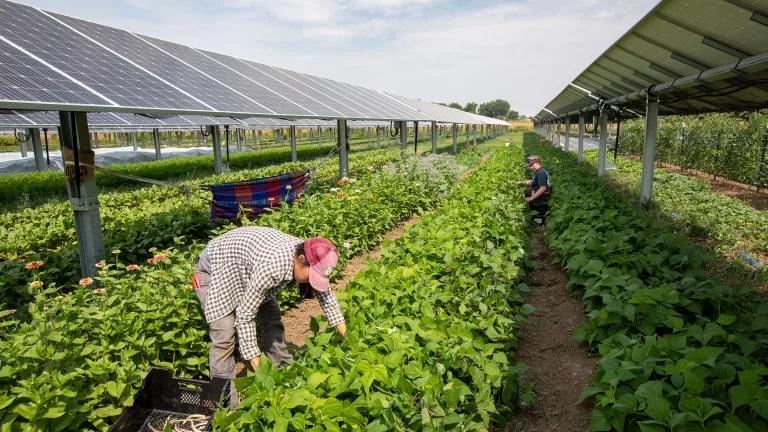For Michigan Farmers, Agricultural Energy-Efficiency Programs Are a Big Source of Savings

Michigan’s second-largest industry is agriculture. The sector provides $92 billion annually to the state’s economy, employs a quarter of its workforce, grew during the economic downturn, and feeds millions of Americans every day.
Michigan’s agricultural sector also uses an extraordinary amount of energy.
Heavy equipment like tractors, milk cooling systems, and grain dryers for removing moisture from seeds all increase productivity on the farm. But their tremendous energy requirements can add up to 34 percent of a farmer’s total costs.
That’s where people like energy efficiency auditor Steve Kinder and agricultural energy expert Aluel “Al” Go come in.
In 2003, the USDA began its Rural Energy for America Program (REAP), which provides loans to farmers and rural businesses to invest in energy efficiency and renewable energy projects. Despite its large agricultural population, Michigan had few projects under the program.
There were several reasons for this: agriculture has long been exempt from many energy efficiency codes, the program did not mesh well with existing utility energy efficiency programs in the state, and an energy auditor shortage in Michigan caused audit prices to skyrocket to more than $10,000 per greenhouse—an expense difficult for farmers to justify. Without savings certainty, few farmers took advantage of REAP grants.
To relieve the agricultural energy auditor shortage, Go developed a training program at Michigan State University. Since 2010, when Go began the program, 80 auditors, including Kinder, have gone through the grueling, five-month program, learning how to audit dairy, grain, greenhouse, and other agricultural operations.
Farm Energy Audit 101
After 31 years as a civil engineer, Kinder was looking for a change, so he went through Go’s training. Today, Kinder is an independent contractor, auditing about 20 farms a year. Each farm energy audit takes a week or two to complete. Based in Ann Arbor but equipped to travel all over the state, Kinder finds most farmers through referrals or through Michigan State. He audits a wide range of farms, from 150-year-old multigenerational family farms to newer, commercially-owned operations.
Kinder’s audits begin by visiting farms and compiling information from the farmer, including three years of energy data, farm size, and an accounting of every motor, engine, building, and everything else that consumes energy. An extensive report aggregates and synthesizes this information. Kinder reviews his findings with the farmer, highlighting the potential for various energy efficiency or renewable energy projects. If Kinder identifies large cost savings opportunities associated with upgrades that are likely to qualify for a REAP grant, the farmer can hire him to write the grant application.
A florist’s greenhouses
Designs by Judy is a greenhouse and florist located about 30 minutes north of Ann Arbor. The family-owned business sells flower arrangements in and around the town of Grass Lake. Kinder was hired by the florist to analyze energy consumption at the business and its four greenhouses, which need to stay within a constant temperature range no matter how hot or cold it gets outside.

Depending on the type of structure at the florist, Kinder recommended a suite of savings opportunities. For example, the owner, Judy Wollet, replaced heaters in the greenhouse with more efficient models, installed energy-efficient lighting in the store, and added a newer furnace.
“These changes have likely helped my business cut costs,” said Wollet, who added that the long, unusually harsh winter last year made it difficult to calculate exact savings.

Auditing dairy farms
Kinder has also worked on one of the biggest energy users of any farm type – dairy farms. When cows are ready to be milked, they step onto moving, energy-intensive automatic—or voluntary—milking systems. Milk is pumped into chillers that cool milk from the cow’s body temperature down to 45 degrees.

The chillers use approximately .7 kWh of electricity per 100 pounds of milk. A typical Michigan dairy operation produces 17.5 million pounds of milk per year, which translates to 122.5 megawatt hours of electricity needed for chilling. That means a typical Michigan dairy farm shells out $13,500 annually just to operate its chiller.
In situations like this, an upgrade Kinder often recommends is replacing a major system component, the compressor, with new $6,000, 20 percent more energy-efficient scroll compressor. This saves individual farmers around $2,700 annually, leading to a return on investment in a little more than two years.
Kinder says that for an upfront cost of $21,800, an average dairy farm audit can identify $8,200 worth of annual energy savings. With less than a three-year payback period, this makes financial sense for lots of farmers.
The future
Extreme weather caused by climate change is already negatively impacting farmers by straining crops and lowering yields. By taking on energy efficiency measures, farmers not only save money – they also reduce the greenhouse gas emissions fueling changes in our climate.
Fortunately, opportunities for enhanced energy efficiency on farms are expanding. The REAP program, efficiency programs run by rural electrical co-ops – many of which have adopted Go’s energy efficiency training program – and commitments to agricultural efficiency by major utilities like Consumers Energy all contribute to advancements in energy efficiency in Michigan’s agricultural sector.
Still, there are shortfalls that could be improved. In recent years, REAP participants have used funds to subsidize equipment, such as new grain dryers—all of which meet REAP efficiency criteria—that they would have purchased anyway. Grain dryers accounted for 25 percent of grants between 2009 and 2012. Since REAP funds simply subsidized new equipment, rather than providing an incentive for the farmer to invest in more energy-efficient equipment, these funds could have driven deeper savings if spent elsewhere.
While there are many improvement opportunities, with every class that graduates from Go’s training program at Michigan State, more professionals are equipped with the skills needed to boost energy efficiency on farms, and to disseminate their knowledge all across Michigan.



